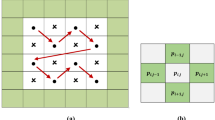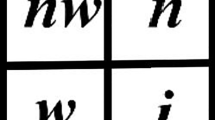Abstract
The paper mainly analyzes four typical reversible data hiding (RDH) algorithms that use PEE technology in combination: Conventional Prediction-error-expansion(C-PEE), Adaptive Prediction-error-expansion(A-PEE), Pairwise Prediction-error-expansion (P-PEE), Improve Pairwise Prediction-error-expansion(IP-PEE). And the experimental comparison results are also given. In addition, in the research process, we found that the peak signal-to-noise ratio (PSNR) and embedding capacity (EC) of many algorithms are very close, due to lack of benchmark tools for technical evaluation in the RDH field, thus this paper proposes a new performance measurement method based on the PSNR and EC measurement, we call it the prediction error accuracy rate, Determined by the ratio of the capacity that meets the embedding conditions to the total capacity of the image, combined with the measurement of this method, can better determine whether the performance of the algorithm is optimal. Finally, in this area, challenge and future directions are also given.












Similar content being viewed by others
Availability of data and material
The test images are downloaded from the USC-SIPI.
Code availability
The materials might remain accessible for permanently.
References
Chen X, Sun X, Sun H, Zhou Z, Zhang J (2013) Reversible watermarking method based on asymmetric-histogram shifting of prediction errors. J Syst Softw 86(10):2620–2626
Coltuc D (2011) Improved embedding for prediction-based reversible watermarking. IEEE Trans Inf Forensics Secur 6(3):873–882
Coltuc D (2012) Low Distortion Transform for Reversible Watermarking. IEEE Trans Image Process 21.1:412–417
Coltuc D, Dragoi IC (2013, June) Context embedding for raster-scan rhombus based reversible watermarking. In: Proceedings of the first ACM workshop on information hiding and multimedia security, pp 215–220
Dragoi IC, Coltuc D (2014) Local-prediction-based difference expansion reversible watermarking. IEEE Trans Image Process 23:1779–1790
Fallahpour M (2008) Reversible image data hiding based on gradient adjusted prediction. IEICE Electron Express 5:870–876
Feng G, Fan L (2012) Reversible data hiding of high payload using local edge sensing prediction. J Syst Softw 85(2):392–399
Feng G, Qian Z, Dai N (2012) Reversible watermarking via extreme learning machine prediction. Neurocomputing 82:62–68
Gui X, Li X, Yang B (2014) A high capacity reversible data hiding scheme based on generalized prediction-error expansion and adaptive embedding. Signal Process 98:370–380
Hong W, Chen TS, Shiu CW (2009) Reversible data hiding for high quality images using modification of prediction errors. J Syst Softw 82.11:1833–1842
Hong, Wien (2010) An Efficient Prediction-and-Shifting Embedding Technique for High Quality Reversible Data Hiding. EURASIP J Adv Signal Process 2010.1:104835
Hsiao JY, Lin ZY, Chen PY (2017) Reversible data hiding based on pairwise prediction-error histogram. J Inf Sci Eng 33(2)
Hu Y, Lee HK, Li J (2009) DE-Based Reversible Data Hiding With Improved Overflow Location Map. IEEE Trans Circuits Syst Video Technol 19.2:250–260
Hwang HJ, Kim HJ, Sachnev V, Joo SH (2010) Reversible watermarking method using optimal histogram pair shifting based on prediction and sorting. KSII Transactions on Internet and Information Systems (TIIS) 4(4):655–670
Jeni M, Srinivasan S (2013, February) Reversible data hiding in videos using low distortion transform. In: 2013 international conference on information communication and embedded systems (ICICES). IEEE, pp 121–124
Leung HY, Cheng LM, Liu F, Fu QK (2013) Adaptive reversible data hiding based on block median preservation and modification of prediction errors. J Syst Softw 86(8):2204–2219
Li X, Li J, Li B, Yang B (2013) High-fidelity reversible data hiding scheme based on pixel-value-ordering and prediction-error expansion. Signal Process 93(1):198–205
Li J, Li X, Yang B (2013) Reversible data hiding scheme for color image based on prediction-error expansion and cross-channel correlation. Signal Process 93(9):2748–2758
Li J, Li X, Yang B (2012, October) A new PEE-based reversible watermarking algorithm for color image. In: 2012 19th IEEE international conference on image processing. IEEE, pp 2181–2184
Li X, Yang B, Zeng T (2011) Efficient reversible watermarking based on adaptive prediction-error expansion and pixel selection. IEEE Trans Image Process 20(12):3524–3533
Li H, Hu L, Chu J, Chi L, Li H (2018) The maximum matching degree sifting algorithm for steganography pretreatment applied to IoT. Multimed Tools Appl 77(14):18203–18221
Li S et al (2020) A Reversible Data Hiding Algorithm Based on Prediction Error With Large Amounts of Data Hiding in Spatial Domain. IEEE Access 8:214732–214741
Li T et al (2020) A reversible steganography method with statistical features maintained based on the difference value. IEEE Access PP 99:1–1
Luo Y, Peng F, Li X, Yang B (2011, July) Reversible image water marking based on prediction-error expansion and compensation. In: 2011 IEEE international conference on multimedia and expo. IEEE, pp 1–6
Malik A, Wang H, Chen Y et al (2020) A reversible data hiding in encrypted image based on prediction-error estimation and location map. Multimed Tools Appl 79:11591–11614
Ou B, Li X, Zhao Y, Ni R (2013) Reversible data hiding based on PDE predictor, J Syst Softw 86 (10)
Ou B, Zhao Y, Ni R (2012) Reversible watermarking using optional prediction error histogram modification. Neurocomputing 93:67–76
Ou B, Li X, Zhao Y, Ni R (2013) Reversible data hiding based on PDE predictor. J Syst Softw 86(10):2700–2709
Ou B et al (2019) Improving Pairwise PEE via Hybrid-Dimensional Histogram Generation and Adaptive Mapping Selection. IEEE Trans Circuits Syst Video Technol 29:2176–2190
Peng F, Li X, Yang B (2012) Adaptive reversible data hiding scheme based on integer transform. Signal Process 92.1:54–62
Puteaux P, Puech W (2018) An efficient MSB prediction-based method for high-capacity reversible data hiding in encrypted images. IEEE Trans Inf Forensics Secur 13:1670–1681
Qi Y, Liu L (2017, May) Reversible watermarking algorithm based on prediction error expansion for color image. In: 2017 32nd youth academic annual conference of Chinese Association of Automation (YAC). IEEE, pp 102–105
Qin C, Chang CC, Liao LT (2012) An adaptive prediction-error expansion oriented reversible information hiding scheme. Pattern Recogn Lett 33.16:2166–2172
Qin C et al (2013) An Inpainting-Assisted Reversible Steganographic Scheme Using a Histogram Shifting Mechanism. IEEE Trans Circuits Syst Video Technol 23.7:1109–1118
Qin C et al (2018) Separable reversible data hiding in encrypted images via adaptive embedding strategy with block selection. Signal Process 153:109–122
Qu X, Kim S, Cui R, Huang F, Kim HJ (2014, October) Reversible data hiding based on combined predictor and prediction error expansion. In: International workshop on digital watermarking. Springer, Cham, pp 254–265
Sachnev V, Hyoung Joong Kim, Jeho Nam, Suresh S, Yun Qing Shi (2009) Reversible watermarking algorithm using sorting and prediction. IEEE Trans Circuits Syst Video Technol 19(7):989–999
Shi X, Xiao D (2013) A reversible watermarking authentication scheme for wireless sensor networks. Inf Sci 240:173–183
Thodi DM, Rodriguez JJ (2007) Expansion embedding techniques for reversible watermarking. IEEE Trans Image Process 16(3):721–730
Tian J (2003) Reversible data embedding using a difference expansion. IEEE Trans Circuits Syst Video Technol 13(8):890–896
Tudoroiu A, Caciula I, Coltuc D (2011, June) Block map implementation of difference expansion reversible watermarking. In: ISSCS 2011- international symposium on signals, circuits and systems. IEEE, pp 1–4
Wang C, Li X, Yang B (2010) Efficient reversible image watermarking by using dynamical prediction-error expansion. Proceedings of the International Conference on Image Processing, ICIP 2010, September 26-29. IEEE, Hong Kong, China
Wu HT, Huang J (2012) Reversible image watermarking on prediction errors by efficient histogram modification. Signal Process 92.12:3000–3009
Wu X, Sun W (2014) High-capacity reversible data hiding in encrypted images by prediction error. Signal Process 104(nov):387–400
Xie XZ, Chang CC, Hu YC (2020) An adaptive reversible data hiding scheme based on prediction error histogram shifting by exploiting signed-digit representation. Multimed Tools Appl 79(33):24329–24346
Xu J, Zhou H, Zhang W, Jiang R, Ma G, Yu N (2017) Second Order Perdicting-Error Sorting for Reversible Data Hiding. Lect Notes Comput Sci 10082:407–420. https://doi.org/10.1007/978-3-319-53465-7_30
Xuan G, Shi YQ, Teng J, Tong X, Chai P (2010, May) Double-threshold reversible data hiding. In: Proceedings of 2010 IEEE international symposium on circuits and systems. IEEE, pp 1129–1132
Xuan G et al (2012) Optimal Histogram-Pair and Prediction-Error Based Image Reversible Data Hiding. International Workshop on Digital Watermarking Springer, Berlin, Heidelberg
Yi S, Zhou Y (2018) Parametric reversible data hiding in encrypted images using adaptive bit-level data embedding and checkerboard based prediction. Signal Process 150:171–182
Yi S, Zhou Y, Hua Z (2018) Reversible data hiding in encrypted images using adaptive block-level prediction-error expansion. Signal Process Image Commun 64:78–88
Zhang X (2013) Reversible data hiding with optimal value transfer. IEEE Trans Multimed 15(2):316–325
Funding
This work is funded by: National Key R&D Plan of China under Grant No. 2017YFA0604500, and by National Sci-Tech Support Plan of China under Grant No. 2014BAH02F00, and by National Natural Science Foundation of China under Grant No. 61701190, and by Youth Science Foundation of Jilin Province of China under Grant No. 20160520011JH &20180520021JH, and by Youth Sci-Tech Innovation Leader and Team Project of Jilin Province of China under Grant No. 20170519017JH, and by Key Technology Innovation Cooperation Project of Government and University for the whole Industry Demonstration under Grant No. SXGJSF2017–4, and by Key scientific and technological R&D Plan of Jilin Province of China under Grant No. 20180201103GX, and by Project of Jilin Province Development and Reform Commission under Grant No. 2019FGWTZC001..
Author information
Authors and Affiliations
Corresponding author
Ethics declarations
Conflicts of interest/competing interests
we have no conflict of interest.
Additional information
Publisher’s note
Springer Nature remains neutral with regard to jurisdictional claims in published maps and institutional affiliations.
Supplementary Information
ESM 1
(RAR 1913 kb)
Rights and permissions
About this article
Cite this article
Li, S., Hu, L., Sun, C. et al. Comparative assessment of PEE methods and new performance measurement for RDH. Multimed Tools Appl 80, 23541–23560 (2021). https://doi.org/10.1007/s11042-021-10938-5
Received:
Revised:
Accepted:
Published:
Issue Date:
DOI: https://doi.org/10.1007/s11042-021-10938-5




